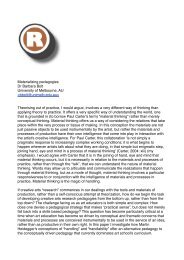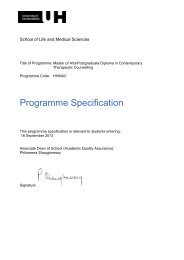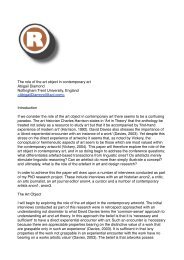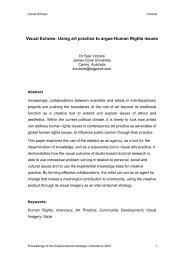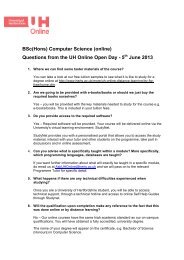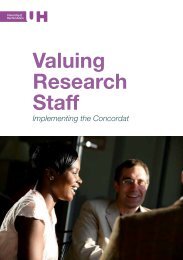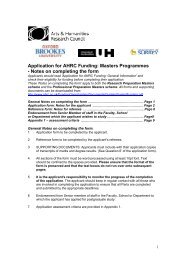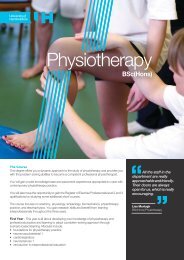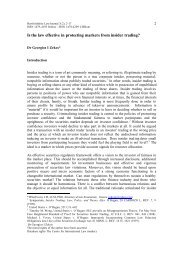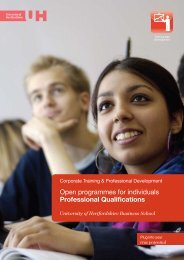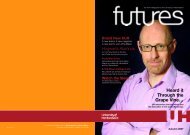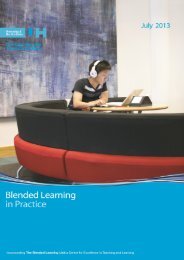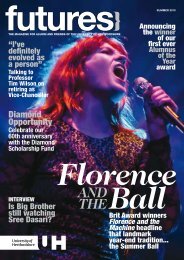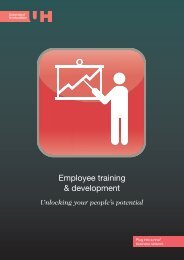June 2009 - University of Hertfordshire
June 2009 - University of Hertfordshire
June 2009 - University of Hertfordshire
Create successful ePaper yourself
Turn your PDF publications into a flip-book with our unique Google optimized e-Paper software.
Senior lecturer to assessor...<br />
37<br />
lecture material.<br />
This led to a number <strong>of</strong> specific questions:<br />
why and how we assess students?<br />
is this necessarily the right way to assess these second year undergraduate<br />
Bioscience students?<br />
how else are these students being assessed to measure the qualities and<br />
skills demanded <strong>of</strong> a pr<strong>of</strong>essional scientist?<br />
Why do we assess students?<br />
The time and attention that goes into designing and moderating examination scripts and<br />
coursework can appear vast. It seems that both lecturer and student lives are dominated<br />
by assessment. Wakeford (2003) describes why assessment is important for two very<br />
different reasons. Firstly, assessment has to be accurate to grade students and set<br />
credible standards both internally and externally to provide quality assurance for all<br />
(Quality Assurance Agency (QAA), 2006). It is now widely accepted that for most students<br />
good assessment is the main driver <strong>of</strong> their learning (Race et al., 2004) and therefore,<br />
secondly, assessment has to be an integral component <strong>of</strong> the teaching and learning<br />
system, aligning it in such a way that it focuses the student activity on meaningful<br />
learning. This is embedded in the <strong>University</strong> <strong>of</strong> <strong>Hertfordshire</strong> learning, teaching and<br />
assessment strategy for 2008-2012. By explicitly implementing transparent assessment<br />
methods that encourage meaningful learning (i.e. relate theory and practice) this will allow<br />
students to measure their own achievements, help them consolidate their learning and<br />
provide feedback to guide improvement for both student and lecturer (Race et al., 2004).<br />
How do we assess students?<br />
There are two approaches to assessment that underlie educational practice; the<br />
traditional norm-referenced whereby students are graded and ranked in relation to one<br />
another and criterion referenced whereby students need to meet preset criteria that reflect<br />
their understanding <strong>of</strong> the learning outcomes, irrespective <strong>of</strong> how they are ranked in their<br />
cohort. Formative assessment and feedback inform students and lecturers on how well<br />
they are learning and teaching and how they can improve, but do not count to the final<br />
grade and are therefore low risk. Summative assessment and feedback on the other hand<br />
are high risk as they count to the final grade/attainment.<br />
Continual summative assessment starts in primary schools (SATs) and continues into<br />
secondary schools (GCSEs) forming an integral part <strong>of</strong> the United Kingdom education<br />
system. It can be argued that continual less formal assessment stimulates learning<br />
through focusing students and providing ongoing feedback, but because it is also<br />
summative it can temporarily shift both student and teacher attention to simply obtaining<br />
the right grades. Many <strong>of</strong> our students are used to this way <strong>of</strong> continual assessment but<br />
now need to adapt to become more active independent learners. A clear distinction<br />
therefore in higher education is the additional need for assessment for learning. Given the<br />
assertion that good assessment and feedback drives learning (Race et al., 2004), one<br />
Blended Learning In Practice <strong>June</strong> <strong>2009</strong>



